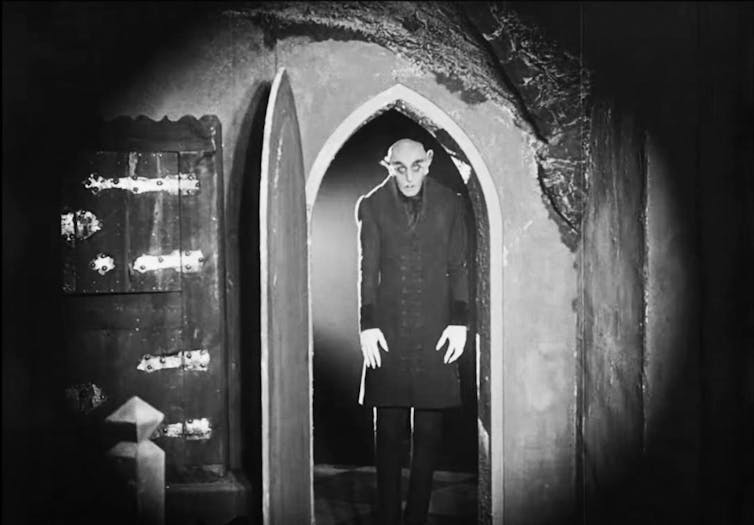26.3.22
Art Therapy Can Enhance Addiction Recovery
23.3.22
Queer Art: Where is the Queer Joy?
View on YouTube
22.3.22
Nosferatu at 100
Nosferatu at 100: how the seminal vampire film shaped the horror genre

It’s the centenary of the cinema premiere of the German horror film Nosferatu. Now recognised as a classic of the silent era and one of the first examples of cinematic horror, it used elements of Gothic style to present a dark dreamworld. Ripe with undertones that link it not only to contemporary troubles, it also offers prescient warnings of horrors to come with the rise of Hitler’s Nazi regime.
The film is now considered one of the key films of German expressionism, a film movement from the 1920s that rejected realism in favour of creating imaginary worlds where stylised and distorted set design expressed psychological states of fear and despair.
Such tortured creation can be linked to external factors, with these films coming out of a Germany still reeling from its defeat in the first world war, plunging the country into a time of turmoil with rising inflation and political unrest. Added to this was the devastation caused by the Spanish flu pandemic of 1918-20, which killed more people than the war.
The film remains a sensation of the horror genre and 100 years since its release it’s influence can still be seen within cinema today.
A complicated legacy
At the centre of the film is the vampire, Count Orlok. Orlok is unlike the dashing caped figures of Bela Lugosi in the 1931 Dracula and Christopher Lee in the series of Dracula films made at Britain’s Hammer Studios.
Actor Max Schreck’s Orlok is strikingly inhuman and repulsive. With his bald head, hooked nose, clawed fingers and pointed ears. He is often surrounded by swarms of rats rather than harems of women. This representation has been compared to hateful anti-Semitic images used in Nazi propaganda. It is unlikely that this was intentional as many of the writers and actors were Jewish. However, the notion of an invading “threat” coming to take over the land and comparisons between Jewish people and vampires were narratives that were used to justify state-sanctioned persecution and murder.
However, a narrative that is inherent in the story of Nosferatu and other expressionist films is the threat of authoritarian and aristocratic figures seeking to take control. The films made in this period foreshadowed a future full of death and terror, tyranny and murder.
In his 1947 history of German expressionism, From Caligari to Hitler, the critic Siegfried Kracauer argued that the genre reflects and documents the subconscious of the German people’s fixation with tyranny that would climax in the rise of the Nazi.
In Nosferatu, this plays out in the aristocratic figure of Orlok who exerts his supernatural influence over unsuspecting people, sucking their lifeblood, choosing who dies and who becomes part of his cabal of hateful monsters who enact his will. For Kracauer, the figure of Count Orlock represented the combination of fear and fascination that the spectre of fascism elicited in the German people.
Immortal and influential
While it is not the first vampire film, or even the first adaptation of Stoker’s novel (the now-lost Hungarian film Dracula’s Death was made a year prior), it established many stylistic and narrative tropes of the vampire story still used today. For instance, Nosferatu was the first time a vampire was killed by sunlight, a trope that has now become canon.
It also was the first German expressionist film to shoot on location, instead of entirely on studio sets – like the genre’s first film The Cabinet of Dr Caligari. For Nosferatu, director F.W. Murnau created a Gothic atmosphere in locations such as Orava Castle and the High Tatras mountain range in Slovakia. Such locations allowed audiences to see and sense the history of crumbling ruins and feel the elemental forces present in dark forests and raging storms.
The making of Nosferatu and its cast and crew have been subject to their own mythologising. The 2000 film Shadow of the Vampire posits that Max Schreck really was a vampire, entering into a Faustian pact with director F. W. Murnau to give his film the ultimate authenticity – in exchange for the blood of the film’s leading lady.
The TV series American Horror Story: Hotel has Murnau himself becoming a vampire while researching Nosferatu in the Carpathian Mountains. Once in Hollywood, Murnau turns an actor into a vampire, the immortality of the vampire likened to the immortality of film stardom.
Nosferatu’s blending of genre tropes and arthouse style even foretells the current rise of “elevated horror”, personified by films such as Get Out, The Babadook and Hereditary. In fact, one of horror’s newest auteurs, Robert Eggers (whose film The Lighthouse owes much to German expressionism), has hinted at a remake of Nosferatu (the second remake after Werner Herzog’s 1979 Nosferatu the Vampyre).
So, after 100 years, our fascination with Count Orlok lives on.![]()
Lindsay Hallam, Senior Lecturer in Film, University of East London
This article is republished from The Conversation under a Creative Commons license. Read the original article.
18.3.22
Patricia Belli - The Scar of the Skin
View on YouTube
Kids React to Art - Cildo Meireles's Babel | Tate #kidsreact #funnyvideo
📻 We asked kids to react to Cildo Meireles's Babel, one of 25 artworks celebrating Tate Modern's 25th birthday, and this is what th...
